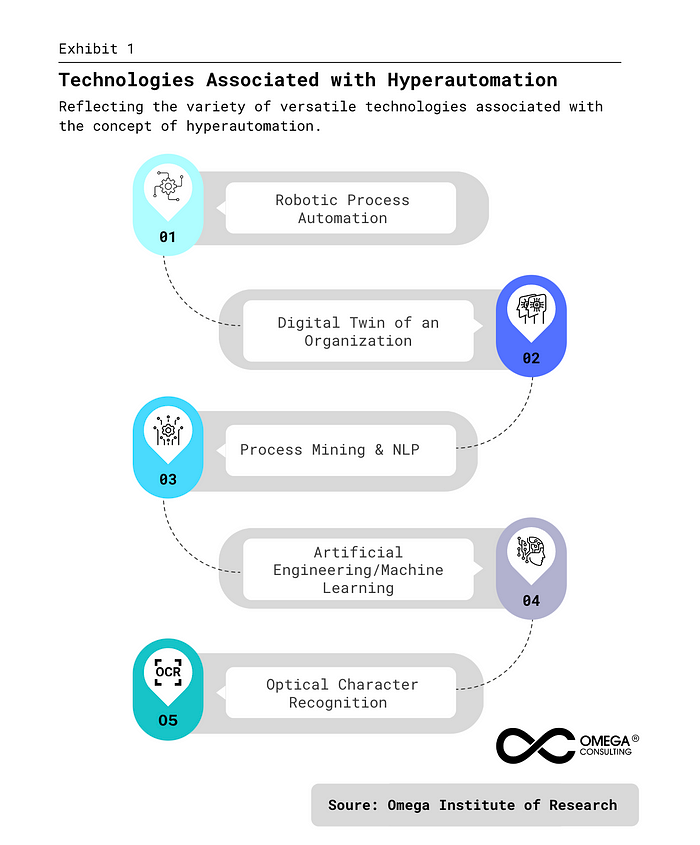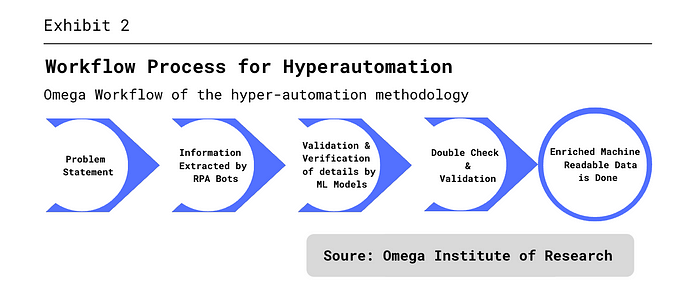- Industries
Industries
- Functions
Functions
- Insights
Insights
- Careers
Careers
- About Us
- Technology
- By Omega Team

Hyperautomation is a technique that uses the advanced automation technology ecosystem to increase human expertise by the organization. It automates complicated business processes, even where topic specialists were formerly needed. This is an expansion to the processes of traditional business-process automation. First time Gartner, an IT research and advisory group, coined hyperautomation in 2019. Gartner’s Top 10 Strategic Technology Trends for 2020 lists hyperautomation at the top.
Basic automation is utilized to do basic and repetitive operations. However, Hyperautomation enables employees to train for the optimum exercise of their responsibilities through the newest marketing knowledge and company insights. The ultimate goal of hyperautomation is to build a mechanism for automating corporate automation. It is a framework and collection of sophisticated technologies for scaling automation in the company. Hyperautomation is a combination of automation technologies and artificial intelligence that, when combined, boost humans’ capabilities, allowing them to execute activities faster, more efficiently, and with fewer errors.
Hyperautomation overcomes some constraints of systems that rely on a single automation tool by leveraging various automation technologies. This enables businesses to go beyond specific procedures and automate practically any time-consuming and scalable operation. Automation, on the other hand, necessitates meticulous preparation and implementation. Organizations must comprehend how digital technologies will integrate into existing workflows and their roles in new processes.
Simply adding automation into a business process without understanding its function will play, or automating a flawed process, can have significant ramifications at the organizational level.
Role of Hyperautomation in the Healthcare Industry
By 2024, Gartner predicts that over 70% of large global enterprises will have over 70 hyperautomation initiatives running simultaneously. Hyperautomation helps businesses:
- Automate business processes
- Increase agility and optimize workflows
- Produce products more quickly by using intelligent insights, improving consistency, and reducing human error
- Reduce costs by replacing manual tasks with automation
Hyperautomation will transform the healthcare industry, and the process has already begun in areas like:
- Scheduling and rescheduling appointments
- Identifying gaps in data and auto-populating patient forms
- Working with insurance agencies to collect missing information. Using Voice Biometric technology to identify patients.
- Leveraging chatbots to answer patient FAQs
- Processing standardization
Hyperautomation also makes a significant impact on analytics and actionable data usage. Healthcare organizations can use process mining and data analytics to improve patient registration and the insurance verification process. Hyperautomation speeds up processes in the healthcare industry and frees up resources so organizations can focus on providing value-based care for patients. Artificial intelligence, machine learning, and robotic process automation make it possible to save time and money for healthcare organizations and the patients they serve. Hyperautomation uses these tools to automate as many repetitive tasks within an organization as possible.
Hyperautomation for Accuracy and Time Saving in Healthcare Industry
The State of California Correctional Healthcare Services uses hyperautomation to help serve more than 98,000 patients. They have automated five boards of pharmacy requirements for drug reconciliation for controlled substances. The bot gathers the information from the Omni cell machines. It calculates and completes all of the reporting information, and then the pharmacist reviews the data for submission. This has helped their 35 pharmacies save about 10 hours a month.
They also utilized hyperautomation during the pandemic for mass testing of patients to handle time-consuming work, send several messages to get results approved, and notify patients. They implemented a new automated bulk ordering system for the labs in early December. And the organization automated the patient notification process. The process first automated the testing orders once they were received. Then automated lab results would go into our electronic health record. Once it populated the electronic health record, if it were a positive test, it would automatically notify the clinicians, which is a game-changer when trying to identify positive COVID tests. If a test were negative, the clinician would approve the results, and a letter would be printed for the patient. According to Larson, this system provided 730,000 notices that would have otherwise been done manually by clinicians.
Case Study
3M Health Information Solutions uses automation as part of its process to improve efficiency in the revenue cycle of healthcare. They do a lot with revenue cycle automation in healthcare, both on the front end with clinician solutions that drive front-end speech and conversational AI with a physician while documenting patient care through the coding process and billing process on the backend. One of the ways that hyperautomation can be used is to help clinicians with documentation rather than having them dictate notes after a patient visit.
Artificial intelligence sits behind these tools and can prompt the physician or nudge them for additional information for clarity and documentation. As a result, you can get a complete picture of the patient during a physician’s office visit. This is a level of creating time to care for the clinician and make their work easier.
Technology Association
The range of adaptable technologies connected to the idea of hyper-automation is shown in the picture below. Process mining, robotic process automation, AI, machine learning techniques, the digital twin of the organization (DTO), optical character recognition (OCR), and natural language processing (NLP) are included (NLP). A hyperautomation tool’s design focuses on processes needing automation and strategic goals. It improves an item’s production and quality assurance. Automation methods are utilized to do low-value labor in hyperautomation. With the right design, autonomous production may operate effectively with the least amount of human participation. People that exhibit hyperautomation may create a flexible, dynamic workplace where data is used to make quick judgments.
Hyperautomation is used to overcome the data limits of an automation technique like RPA. Technology hyperautomation can handle structured and unstructured data, whereas RPA is limited to structured data. Obtaining and analyzing data enables the industry to gain critical organizational insights. Hyperautomation can be transformed into organizing unstructured data for use with RPA technology. This relationship serves as an example of how well various digital tools can work together. Business analysts, subject matter experts, and the remaining business users all play a crucial role in the transformation process’ ability to have an additional impact on everyone. Robotics and human function are made possible by hyperautomation technologies. Tools that are versatile and easy to integrate may be used by business users. Running processes and taking time to perform smaller-scope tasks will help you automate.
A digital technology ecosystem is involved in the following stage of manufacturing. Hyper-automation produces a distinctive process ecosystem by combining several modern autonomous technologies. With clear visibility of the time and money saved from the number of operations that have been automated, it would be simple for businesses with hyperautomation to truly appreciate the return that they can generate. The hyper-automation system offers seamless communication, adaptability, and digital agility between various data systems enterprises use. Businesses gain from the increased output, compliance, insights, analytics, and automated processes.

Workflow Process For Hyperautomation
This starts with the problem statement step, which proceeds toward the information extracted by RPA bots, followed by validation & verification of details by ML models. The step of double-check validation has been considered, and in the end, the enriched machine-readable data is completed and validated. With more comprehensive automation opportunities, hyperautomation enables the ability to more easily cross organizational boundaries.
It aids in the automation of a number of business decision-making processes. These include quick process automation, sophisticated analytical applications, more employee satisfaction and motivation, work that adds value to the workforce, more precise insights, better compliance, reduced risk, increased productivity, and improved teamwork. The emphasis is on achieving end-to-end process automation as businesses leverage a more comprehensive range of automation solutions to remove functional and procedural constraints.

Future of Hyperautomation
Hyperautomation is an upcoming technological transformation that will continue to impact companies across the healthcare industry. People may concentrate on those with a more excellent value for the business, free from repetitive and low-value jobs. Automation and human participation combine to give enterprises enhanced client experience, reduce operating costs, and increase profitability. Hyper-automation enables staff to be trained to do their task optimally with updated business and market knowledge.
Conclusion
AI is paired with automation to tackle difficult issues and simplify operations. Hyperautomation may bring people together, with technology and people working side by side and together. It utilizes the technology to analyze big data and apply insights to its company as influential policymakers by optimizing corporate processes by reducing repetitive operations and automating manual ones, hyper-automation changes enterprises. It enables companies to do operations with consistency, precision, and speed.
As a result, prices are reduced, and customer experiences are typically improved. Many firms have made investments in new technology to overcome constraints. With hyperautomation, the company can automatically automate activities to enhance productivity and provide the client with more value. Hyperautomation is sophisticated automation that seems quicker, more efficient, and makes fewer mistakes to complete activities and processes. Thus, it provides the intended results and the essential value requirements, such as revenue, cost savings, and risk management.
Subscribe
Select topics and stay current with our latest insights
- Functions